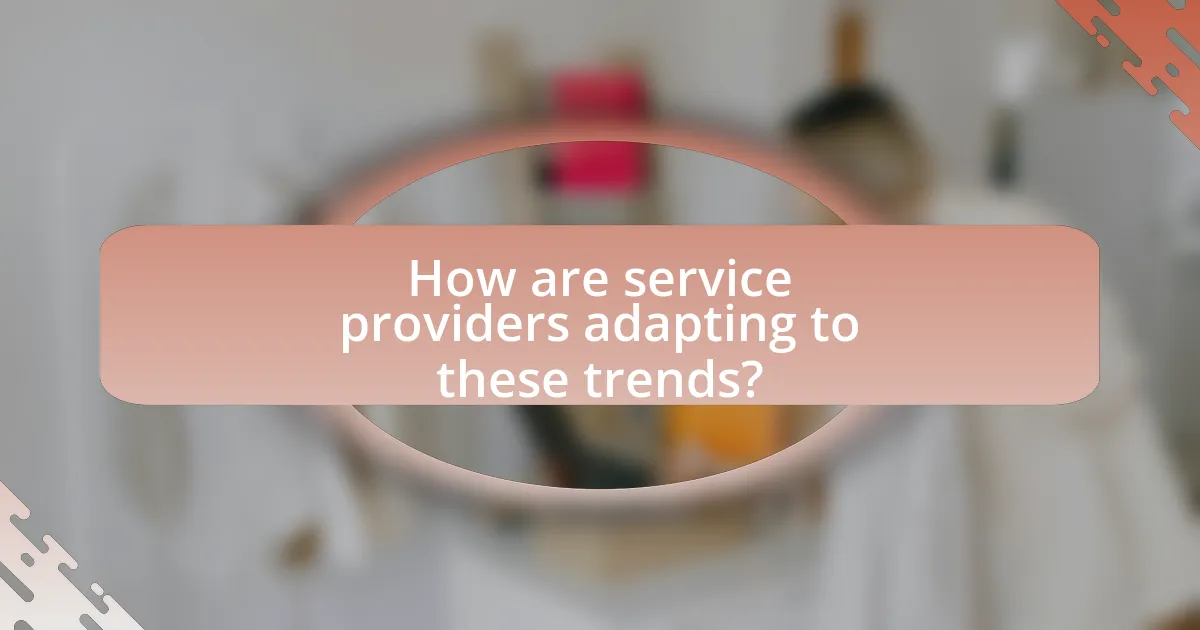The article focuses on the future of Virtual Private Server (VPS) hosting, highlighting key trends expected to shape the industry in 2024. It discusses the increasing automation, enhanced security measures, and the adoption of cloud-native technologies that are driving demand for VPS hosting solutions. The article also examines the evolving user expectations, technological advancements, and emerging security trends that influence VPS hosting services. Additionally, it outlines best practices for selecting a VPS provider, optimizing user experience, and managing resources effectively, while addressing common pitfalls to avoid in VPS hosting.

What are the key trends shaping the future of VPS hosting in 2024?
The key trends shaping the future of VPS hosting in 2024 include increased automation, enhanced security measures, and the adoption of cloud-native technologies. Automation is streamlining server management, allowing for quicker deployment and scaling, which is essential as businesses demand more agility. Enhanced security measures, such as advanced firewalls and DDoS protection, are becoming critical due to the rising frequency of cyber threats; for instance, a report from Cybersecurity Ventures predicts that cybercrime will cost the world $10.5 trillion annually by 2025. Additionally, the shift towards cloud-native technologies is facilitating better resource utilization and flexibility, as organizations increasingly prefer hybrid and multi-cloud environments to optimize performance and cost. These trends reflect the evolving needs of businesses for reliable, secure, and efficient hosting solutions.
How is the demand for VPS hosting evolving in the current market?
The demand for VPS hosting is increasing significantly in the current market, driven by the growing need for scalable and cost-effective solutions among businesses. According to a report by MarketsandMarkets, the VPS hosting market is projected to grow from USD 3.4 billion in 2021 to USD 6.5 billion by 2026, reflecting a compound annual growth rate (CAGR) of 14.5%. This growth is attributed to the rising adoption of cloud services, the need for enhanced security, and the flexibility that VPS hosting offers compared to traditional shared hosting. Additionally, the shift towards remote work and digital transformation initiatives has further accelerated the demand for reliable and customizable hosting solutions.
What factors are driving the increased adoption of VPS hosting?
The increased adoption of VPS hosting is primarily driven by the demand for cost-effective scalability and enhanced performance. Businesses are increasingly seeking flexible hosting solutions that allow them to scale resources according to their needs without incurring the high costs associated with dedicated servers. Additionally, VPS hosting offers improved performance through dedicated resources, which is crucial for applications requiring consistent uptime and speed. According to a report by MarketsandMarkets, the global VPS hosting market is expected to grow significantly, reflecting the rising preference for virtual private servers among small to medium-sized enterprises looking for reliable and affordable hosting options.
How do user expectations influence VPS hosting trends?
User expectations significantly influence VPS hosting trends by driving demand for enhanced performance, scalability, and security features. As users increasingly seek reliable and efficient hosting solutions, providers are compelled to innovate and improve their offerings. For instance, a survey by HostingAdvice in 2022 indicated that 70% of users prioritize uptime and speed, prompting VPS providers to adopt advanced technologies like SSD storage and optimized server configurations to meet these expectations. Additionally, the growing emphasis on data privacy has led to a trend towards more robust security measures, such as DDoS protection and regular security audits, aligning with user demands for safer hosting environments.
What technological advancements are impacting VPS hosting?
Technological advancements impacting VPS hosting include containerization, improved virtualization technologies, and enhanced security protocols. Containerization, exemplified by Docker and Kubernetes, allows for more efficient resource utilization and faster deployment of applications, which optimizes server performance. Improved virtualization technologies, such as KVM and VMware, provide better isolation and scalability, enabling VPS providers to offer more robust services. Enhanced security protocols, including advanced firewalls and DDoS protection, are crucial as cyber threats evolve, ensuring that VPS environments remain secure. These advancements collectively contribute to a more efficient, scalable, and secure VPS hosting landscape.
How is cloud technology transforming VPS hosting services?
Cloud technology is transforming VPS hosting services by enhancing scalability, flexibility, and resource allocation. With cloud infrastructure, VPS providers can offer on-demand resources, allowing users to easily scale their hosting plans based on traffic and performance needs. This shift enables businesses to pay only for the resources they utilize, optimizing costs. Additionally, cloud technology facilitates improved uptime and reliability through distributed data centers, which reduce the risk of downtime. According to a report by MarketsandMarkets, the global cloud computing market is expected to grow from $371.4 billion in 2020 to $832.1 billion by 2025, indicating a significant trend towards cloud-based solutions in various sectors, including VPS hosting.
What role does virtualization play in the future of VPS hosting?
Virtualization is central to the future of VPS hosting as it enables efficient resource allocation and scalability. By allowing multiple virtual servers to run on a single physical server, virtualization optimizes hardware usage, reduces costs, and enhances flexibility for users. According to a report by MarketsandMarkets, the global virtualization market is expected to grow from $5.5 billion in 2020 to $12.5 billion by 2025, indicating a strong trend towards increased adoption in hosting environments. This growth underscores the importance of virtualization in providing businesses with the ability to quickly scale resources up or down based on demand, ensuring that VPS hosting remains competitive and responsive to market needs.
What are the emerging security trends in VPS hosting?
Emerging security trends in VPS hosting include increased adoption of containerization, enhanced DDoS protection, and the implementation of AI-driven security measures. Containerization allows for isolated environments, reducing the risk of cross-contamination between applications. Enhanced DDoS protection is becoming essential as attacks grow in frequency and sophistication; for instance, a report from Cloudflare indicated a 200% increase in DDoS attacks in 2022. AI-driven security measures utilize machine learning to detect and respond to threats in real-time, improving overall security posture. These trends reflect the evolving landscape of cybersecurity in VPS hosting, addressing both current vulnerabilities and future threats.
How are cybersecurity threats evolving for VPS users?
Cybersecurity threats for VPS users are evolving through increased sophistication of attacks, particularly with the rise of automated tools and artificial intelligence. Attackers are leveraging advanced techniques such as distributed denial-of-service (DDoS) attacks, which have grown in scale and complexity, targeting VPS environments to disrupt services. Additionally, the use of ransomware has surged, with cybercriminals specifically targeting VPS users due to their often limited security measures compared to larger enterprises. According to a report by Cybersecurity Ventures, ransomware damages are expected to reach $265 billion by 2031, highlighting the urgency for VPS users to enhance their security protocols. Furthermore, the emergence of zero-day vulnerabilities poses significant risks, as attackers exploit unpatched software in VPS systems before developers can respond. This evolving landscape necessitates that VPS users adopt proactive security measures, including regular updates, robust firewalls, and comprehensive monitoring solutions.
What security measures are becoming standard in VPS hosting?
Security measures becoming standard in VPS hosting include enhanced firewalls, DDoS protection, regular security updates, and automated backups. Enhanced firewalls protect against unauthorized access by filtering incoming and outgoing traffic based on predetermined security rules. DDoS protection mitigates the risk of distributed denial-of-service attacks, ensuring service availability. Regular security updates address vulnerabilities in the operating system and software, reducing the risk of exploitation. Automated backups ensure data integrity and availability, allowing for quick recovery in case of data loss. These measures are increasingly adopted as VPS providers prioritize customer security and compliance with industry standards.

How are service providers adapting to these trends?
Service providers are adapting to trends in VPS hosting by enhancing their infrastructure and offering more flexible solutions. They are investing in advanced virtualization technologies to improve performance and scalability, allowing customers to easily adjust resources based on demand. Additionally, many providers are implementing automation and AI-driven management tools to streamline operations and reduce costs. For instance, a report from MarketsandMarkets indicates that the global VPS hosting market is expected to grow significantly, prompting providers to innovate and stay competitive. This adaptation ensures that service providers can meet the evolving needs of businesses seeking reliable and efficient hosting solutions.
What new features are VPS hosting providers offering in 2024?
VPS hosting providers are offering enhanced security features, including advanced DDoS protection and automated backups in 2024. These improvements are designed to safeguard user data and ensure uptime, addressing the increasing threats in the digital landscape. Additionally, many providers are integrating AI-driven resource management tools that optimize performance and scalability based on real-time usage patterns, which enhances efficiency and user experience.
How do these features enhance user experience and performance?
These features enhance user experience and performance by providing greater flexibility, scalability, and reliability in VPS hosting. Enhanced flexibility allows users to customize their server environments according to specific needs, which leads to improved application performance. Scalability ensures that resources can be adjusted in real-time to accommodate varying traffic loads, preventing downtime and maintaining optimal performance levels. Reliability is achieved through advanced monitoring and automated backups, which minimize data loss and ensure consistent uptime. According to a study by HostingAdvice, 99.9% uptime is achievable with modern VPS solutions, directly correlating to improved user satisfaction and engagement.
What pricing models are becoming popular among VPS hosting providers?
Subscription-based pricing models are becoming popular among VPS hosting providers. This model allows customers to pay a recurring fee for access to virtual private servers, providing predictable costs and easier budget management. Additionally, usage-based pricing is gaining traction, where customers are charged based on their actual resource consumption, aligning costs with demand. According to a report by HostingAdvice, 60% of VPS providers have adopted subscription models in the last two years, reflecting a shift towards more flexible and customer-centric pricing strategies.
How are customer support and service levels changing in VPS hosting?
Customer support and service levels in VPS hosting are evolving towards greater automation and enhanced personalization. The integration of AI-driven chatbots and support systems is streamlining response times, allowing for 24/7 assistance and quicker resolution of common issues. According to a report by Gartner, by 2024, 75% of customer interactions will be managed by AI, indicating a significant shift in how support is delivered. Additionally, VPS providers are increasingly offering tailored service plans that cater to specific customer needs, reflecting a trend towards more customized support experiences. This shift is driven by the growing demand for efficient, responsive service in a competitive market.
What support options are now available for VPS users?
VPS users now have access to multiple support options, including 24/7 technical support, live chat assistance, and comprehensive knowledge bases. These support channels ensure that users can receive timely help with server management, troubleshooting, and optimization. The availability of round-the-clock support is crucial for maintaining uptime and addressing issues as they arise, which is particularly important in the competitive landscape of VPS hosting.
How does customer feedback influence service improvements?
Customer feedback directly influences service improvements by providing actionable insights that help businesses identify areas needing enhancement. For instance, when customers express dissatisfaction with specific features of a VPS hosting service, companies can prioritize updates or modifications to address these concerns. Research indicates that organizations that actively seek and implement customer feedback can improve customer satisfaction by up to 20%, as noted in a study by Bain & Company. This demonstrates that leveraging customer insights not only enhances service quality but also fosters customer loyalty and retention.

What are the best practices for choosing a VPS hosting provider in 2024?
The best practices for choosing a VPS hosting provider in 2024 include evaluating performance, scalability, customer support, security features, and pricing. Performance is crucial; providers should offer high uptime rates, ideally above 99.9%, and fast server response times, which can be verified through independent reviews and benchmarks. Scalability is important as businesses grow; a good provider should allow easy upgrades to resources without significant downtime. Customer support should be available 24/7 through multiple channels, including live chat and phone, as timely assistance is vital for resolving issues. Security features must include regular backups, DDoS protection, and SSL certificates, which are essential for safeguarding data. Lastly, pricing should be transparent with no hidden fees, and it should reflect the quality of services offered, allowing for a cost-effective solution that meets specific needs.
What criteria should users consider when selecting a VPS hosting service?
Users should consider performance, scalability, support, security, and pricing when selecting a VPS hosting service. Performance is crucial as it affects website speed and reliability; users should look for high uptime guarantees and fast SSD storage. Scalability allows users to adjust resources as their needs grow, ensuring the service can accommodate increased traffic. Support is essential; 24/7 customer service can resolve issues quickly, minimizing downtime. Security features, such as DDoS protection and regular backups, protect data and maintain service integrity. Finally, pricing should be transparent, with no hidden fees, allowing users to assess the overall value of the service.
How important are uptime guarantees and performance metrics?
Uptime guarantees and performance metrics are critically important in VPS hosting as they directly impact service reliability and user satisfaction. High uptime percentages, typically above 99.9%, ensure that services remain accessible, which is essential for businesses that rely on consistent online presence. Performance metrics, such as response time and resource allocation, provide insights into how well the VPS is functioning, allowing users to optimize their applications effectively. According to a study by the Uptime Institute, downtime can cost businesses an average of $5,600 per minute, highlighting the financial implications of inadequate uptime. Therefore, both uptime guarantees and performance metrics are essential for maintaining operational efficiency and customer trust in VPS hosting.
What role do customer reviews play in the decision-making process?
Customer reviews significantly influence the decision-making process by providing potential customers with insights into product quality and user experiences. Research indicates that approximately 79% of consumers trust online reviews as much as personal recommendations, highlighting their impact on purchasing decisions. Furthermore, a study by BrightLocal found that 87% of consumers read online reviews for local businesses, demonstrating that reviews serve as a critical factor in evaluating options. This reliance on customer feedback helps individuals make informed choices, ultimately shaping their perceptions and actions regarding products and services.
What tips can help users optimize their VPS hosting experience?
To optimize their VPS hosting experience, users should regularly monitor resource usage, implement security measures, and utilize performance-enhancing tools. Regular monitoring of CPU, RAM, and bandwidth helps identify bottlenecks and allows for timely upgrades or adjustments. Implementing security measures, such as firewalls and regular updates, protects against vulnerabilities, which is crucial as cyber threats continue to evolve. Additionally, using performance-enhancing tools like caching solutions and content delivery networks (CDNs) can significantly improve load times and overall site performance. These practices are supported by industry standards, which emphasize the importance of resource management and security in maintaining optimal server performance.
How can users effectively manage resources on their VPS?
Users can effectively manage resources on their VPS by utilizing monitoring tools, optimizing configurations, and implementing resource allocation strategies. Monitoring tools such as Nagios or Zabbix provide real-time insights into CPU, memory, and disk usage, allowing users to identify bottlenecks and adjust resources accordingly. Optimizing configurations, such as adjusting web server settings or database parameters, can enhance performance and reduce resource consumption. Additionally, implementing resource allocation strategies, like setting limits on user processes or using containerization, ensures that resources are distributed efficiently among applications. These practices are supported by industry standards, which emphasize the importance of proactive resource management for maintaining optimal VPS performance.
What common pitfalls should users avoid when using VPS hosting?
Users should avoid several common pitfalls when using VPS hosting, including inadequate resource allocation, neglecting security measures, and failing to monitor performance. Inadequate resource allocation can lead to slow performance and downtime, as users may underestimate their needs for CPU, RAM, and storage. Neglecting security measures, such as not implementing firewalls or regular updates, can expose the server to vulnerabilities and attacks. Additionally, failing to monitor performance can result in unaddressed issues that affect the user experience, as users may not be aware of resource bottlenecks or potential outages. These pitfalls can significantly impact the effectiveness and reliability of VPS hosting services.


